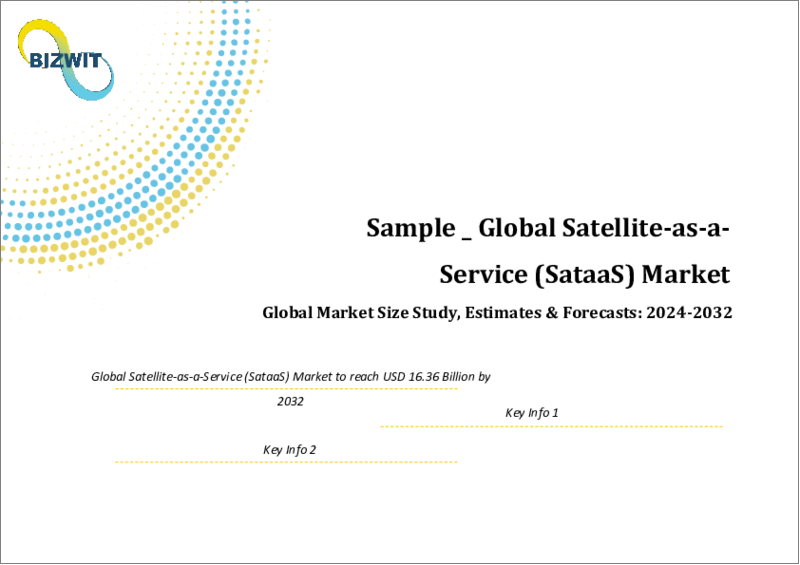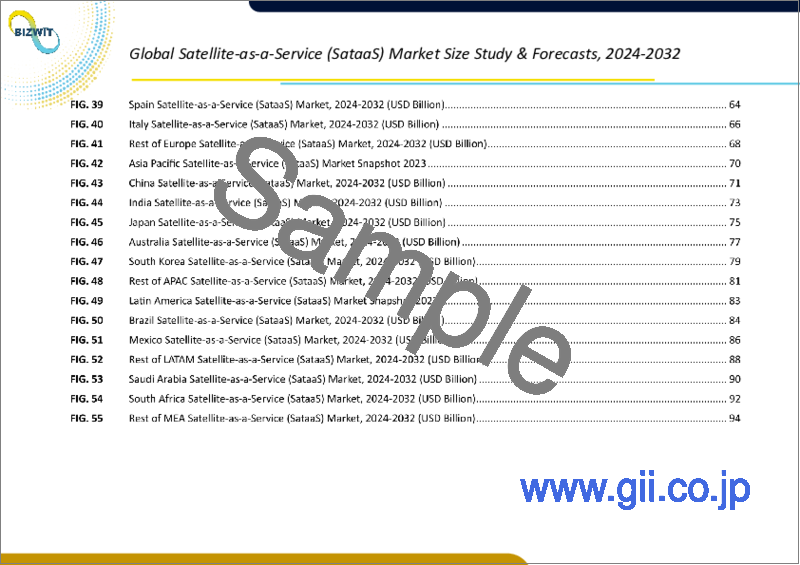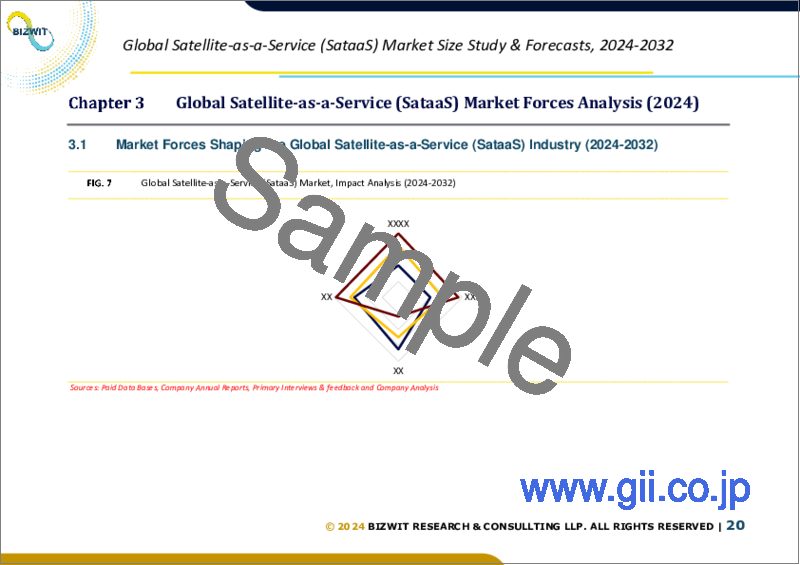|
|
市場調査レポート
商品コード
1543694
衛星通信サービス(SataaS)の世界市場規模調査:衛星タイプ別、用途別、地域別予測:2022-2032年Global Satellite-as-a-Service (SataaS) Market Size Study, by Satellite Type (Small Satellites, Large Satellites), by Application (Internet Service, Communication Service, Track Service) and Regional Forecasts 2022-2032 |
||||||
カスタマイズ可能
|
|||||||
| 衛星通信サービス(SataaS)の世界市場規模調査:衛星タイプ別、用途別、地域別予測:2022-2032年 |
|
出版日: 2024年08月25日
発行: Bizwit Research & Consulting LLP
ページ情報: 英文 285 Pages
納期: 2~3営業日
|
全表示
- 概要
- 目次
世界の衛星通信サービス(SataaS)市場は、2023年に約44億3,000万米ドルと評価され、2024年から2032年までの予測期間中に15.62%の複合年間成長率(CAGR)で成長すると予測されています。
衛星通信サービス(SataaS)は、クラウドベースのモデルを通じて衛星機能へのオンデマンド・アクセスを提供し、企業や組織が物理的な衛星を所有または運用することなく衛星データやサービスを利用できるようにします。このモデルは、ユーザーが必要に応じて衛星画像、通信、その他の機能を活用できるようにすることで、柔軟性、拡張性、コスト効率を提供します。SaaSは、衛星の管理やインフラの複雑さを排除し、地球観測から世界・コネクティビティまで、幅広い用途で高度な宇宙ベースの技術を利用できるようにします。様々な業界における衛星データやサービスに対する需要の高まりと、衛星技術の急速な進歩が相まって、SataaS市場の成長を牽引しています。リアルタイムで高解像度の衛星画像にアクセスできるため、企業や組織はさまざまなパラメーターを監視・分析でき、より効率的で効果的な業務が可能になります。
気候監視、災害管理、都市計画などの用途で地球観測やリモートセンシング・データのニーズが高まっていることが、衛星サービスの需要を大幅に押し上げています。政府、環境機関、民間企業は、持続可能な開発とリスク軽減のための貴重な洞察を得るために衛星技術を活用しています。さらに、特に遠隔地やサービスが行き届いていない地域での世界な接続に対する需要の高まりが、衛星通信サービス(SataaS)の成長を後押ししています。SataaSプロバイダーは、ブロードバンドインターネット、音声通信、データ転送のソリューションを提供しており、デジタルデバイドを解消し、従来のインフラの導入が困難な地域を接続するのに役立っています。さらに、宇宙産業は商業化が進んでおり、非公開会社が市場に参入し、革新的な衛星通信サービスを提供しています。この競争は技術革新を促進し、コストを削減し、サービス内容を拡大し、SataaS市場全体の成長に寄与しています。さらに、高性能センサーの開発、小型化、打上げ能力の向上など、衛星技術の進歩が続いており、衛星の能力が向上しているため、SataaSプロバイダーはユーザーの進化するニーズに対応するため、より高度で多様なサービスを提供できるようになっています。
世界の衛星通信サービス(SataaS)市場の主要地域には、北米、欧州、アジア太平洋、ラテンアメリカ、中東・アフリカが含まれます。2023年、北米のSataaS市場は、高度な技術インフラ、宇宙企業の強固なエコシステム、多様な産業における衛星ベースのサービスに対する高い需要により、収益面で優位を占めています。大手衛星通信事業者、革新的新興企業、有利な規制枠組みが存在するため、北米はSataaSの主要拠点として位置付けられています。欧州は、地球観測、通信、ナビゲーションなどの用途で衛星技術の活用を重視する傾向が強まっていることから、第2位の市場シェアを占めています。アジア太平洋地域は、急速な技術進歩に後押しされた衛星ベースの通信、地球観測、接続サービスの需要増加により、最も速いCAGRで成長すると予想されます。
目次
第1章 衛星通信サービス(SataaS)の世界市場エグゼクティブサマリー
- 世界の衛星通信サービス(SataaS)市場規模・予測(2022-2032年)
- 地域別サマリー
- セグメント別サマリー
- 衛星タイプ別
- 用途別
- 主要動向
- 景気後退の影響
- アナリストの結論・提言
第2章 世界の衛星通信サービス(SataaS)市場の定義と調査前提条件
- 調査目的
- 市場定義
- 調査前提条件
- 包含と除外
- 制限事項
- 供給サイドの分析
- 入手可能性
- インフラ
- 規制環境
- 市場競争
- 経済性(消費者の視点)
- 需要サイド分析
- 規制の枠組み
- 技術の進歩
- 環境への配慮
- 消費者の意識と受容
- 調査手法
- 調査対象年
- 通貨換算レート
第3章 世界の衛星通信サービス(SataaS)市場力学
- 市場促進要因
- 衛星データおよびサービスに対する需要の高まり
- 衛星技術の進歩
- 宇宙の商業化の進展
- 市場の課題
- 初期コストの高さ
- 規制とコンプライアンスの問題
- 市場機会
- 新興市場での拡大
- 費用対効果の高い小型衛星の開発
- 衛星通信サービスの革新
第4章 世界の衛星通信サービス(SataaS)市場産業分析
- ポーターのファイブフォースモデル
- 供給企業の交渉力
- 買い手の交渉力
- 新規参入業者の脅威
- 代替品の脅威
- 競争企業間の敵対関係
- ポーターのファイブフォースモデルへの未来的アプローチ
- ポーターのファイブフォースの影響分析
- PESTEL分析
- 政治
- 経済
- 社会
- 技術
- 環境
- 法律
- 主な投資機会
- 主要成功戦略
- 破壊的動向
- 業界専門家の視点
- アナリストの結論・提言
第5章 衛星通信サービス(SataaS)の世界市場規模・予測:衛星タイプ別、2022年~2032年
- セグメントダッシュボード
- 世界の衛星通信サービス(SataaS)市場:収益動向分析、2022年・2032年
- 小型衛星
- 大型衛星
第6章 衛星通信サービス(SataaS)の世界市場規模・予測:用途別、2022年~2032年
- セグメントダッシュボード
- 世界の衛星通信サービス(SataaS)市場:収益動向分析、2022年・2032年
- インターネットサービス
- 通信サービス
- 追跡サービス
第7章 衛星通信サービス(SataaS)の世界市場規模・予測:地域別、2022年~2032年
- 北米
- 米国
- カナダ
- 欧州
- 英国
- ドイツ
- フランス
- スペイン
- イタリア
- その他欧州
- アジア太平洋
- 中国
- インド
- 日本
- オーストラリア
- 韓国
- その他アジア太平洋地域
- ラテンアメリカ
- ブラジル
- メキシコ
- その他ラテンアメリカ
- 中東・アフリカ
- サウジアラビア
- 南アフリカ
- その他中東とアフリカ
第8章 競合情報
- 主要企業のSWOT分析
- 主要市場戦略
- 企業プロファイル
- SpaceX
- 主要情報
- 概要
- 財務(データの入手可能性によります)
- 製品概要
- 市場戦略
- Planet Labs Inc.
- OneWeb
- Spire Global Inc.
- Capella Space
- HawkEye 360
- Astro Digital Inc.
- Loft Orbital
- Orbital Insight
- Satellogic
- SES S.A.
- Thales Alenia Space
- Airbus Defence and Space
- Maxar Technologies Inc.
- Iridium Communications Inc.
- SpaceX
第9章 調査プロセス
- 調査プロセス
- データマイニング
- 分析
- 市場推定
- 検証
- 出版
- 調査属性
Global Satellite-as-a-Service (SataaS) Market was valued at approximately USD 4.43 Billion in 2023 and is anticipated to grow at a compound annual growth rate (CAGR) of 15.62% over the forecast period from 2024 to 2032. Satellite-as-a-Service (SaaS) offers on-demand access to satellite capabilities via a cloud-based model, enabling businesses and organizations to utilize satellite data and services without owning or operating physical satellites. This model provides flexibility, scalability, and cost efficiency by allowing users to leverage satellite imagery, communications, and other functions as needed. SaaS eliminates the complexities of satellite management and infrastructure, making advanced space-based technology accessible for a wide range of applications, from Earth observation to global connectivity. The rising demand for satellite data and services across various industries, coupled with rapid advancements in satellite technology, is driving the growth of the SataaS market. The ability to access real-time and high-resolution satellite imagery allows businesses and organizations to monitor and analyze various parameters, thereby enabling more efficient and effective operations.
The increasing need for Earth observation and remote sensing data for applications such as climate monitoring, disaster management, and urban planning is significantly boosting the demand for satellite services. Governments, environmental agencies, and private enterprises are leveraging satellite technology to obtain valuable insights for sustainable development and risk mitigation. Furthermore, the growing demand for global connectivity, especially in remote or underserved areas, is propelling the growth of satellite-based communication services. SataaS providers are offering solutions for broadband internet, voice communication, and data transfer, which help bridge the digital divide and connect regions where traditional infrastructure may be challenging to deploy. Furthermore, the space industry is experiencing increased commercialization, with private companies entering the market and offering innovative satellite services. This competition fosters innovation, reduces costs, and expands service offerings, contributing to the overall growth of the SataaS market. Additionally, ongoing advancements in satellite technology, such as the development of high-performance sensors, miniaturization, and improved launch capabilities, enhance the capabilities of satellites, enabling SataaS providers to offer more sophisticated and diverse services to meet the evolving needs of users.
The key regions in the Global Satellite-as-a-Service (SataaS) Market includes North America, Europe, Asia Pacific, Latin America, and Middle East & Africa. In 2023, North American SataaS market dominates in terms of revenue due to its advanced technological infrastructure, robust ecosystem of space companies, and high demand for satellite-based services across diverse industries. The presence of major satellite operators, innovative startups, and favorable regulatory frameworks has positioned North America as a key hub for SataaS. Europe holds the second-largest market share, driven by the region's increasing emphasis on leveraging satellite technology for applications such as Earth observation, telecommunications, and navigation. The Asia-Pacific region is expected to grow at the fastest CAGR, driven by increasing demand for satellite-based communication, Earth observation, and connectivity services fueled by rapid technological advancements.
Major market players in this report include:
- SpaceX
- Planet Labs Inc.
- OneWeb
- Spire Global Inc.
- Capella Space
- HawkEye 360
- Astro Digital Inc.
- Loft Orbital
- Orbital Insight
- Satellogic
- SES S.A.
- Thales Alenia Space
- Airbus Defence and Space
- Maxar Technologies Inc.
- Iridium Communications Inc.
The detailed segments and sub-segment of the market are explained below:
By Satellite Type
- Small Satellites
- Large Satellites
By Application
- Internet Service
- Communication Service
- Track Service
By Region:
- North America
- U.S.
- Canada
- Europe
- UK
- Germany
- France
- Spain
- Italy
- ROE
- Asia Pacific
- China
- India
- Japan
- Australia
- South Korea
- RoAPAC
- Latin America
- Brazil
- Mexico
- Rest of Latin America
- Middle East & Africa
- Saudi Arabia
- South Africa
- RoMEA
Years considered for the study are as follows:
- Historical year - 2022
- Base year - 2023
- Forecast period - 2024 to 2032
Key Takeaways:
- Market Estimates & Forecast for 10 years from 2022 to 2032.
- Annualized revenues and regional level analysis for each market segment.
- Detailed analysis of geographical landscape with Country level analysis of major regions.
- Competitive landscape with information on major players in the market.
- Analysis of key business strategies and recommendations on future market approach.
- Analysis of competitive structure of the market.
- Demand side and supply side analysis of the market.
Table of Contents
Chapter 1. Global Satellite-as-a-Service (SataaS) Market Executive Summary
- 1.1. Global Satellite-as-a-Service (SataaS) Market Size & Forecast (2022-2032)
- 1.2. Regional Summary
- 1.3. Segmental Summary
- 1.3.1. By Satellite Type
- 1.3.2. By Application
- 1.4. Key Trends
- 1.5. Recession Impact
- 1.6. Analyst Recommendation & Conclusion
Chapter 2. Global Satellite-as-a-Service (SataaS) Market Definition and Research Assumptions
- 2.1. Research Objective
- 2.2. Market Definition
- 2.3. Research Assumptions
- 2.3.1. Inclusion & Exclusion
- 2.3.2. Limitations
- 2.3.3. Supply Side Analysis
- 2.3.3.1. Availability
- 2.3.3.2. Infrastructure
- 2.3.3.3. Regulatory Environment
- 2.3.3.4. Market Competition
- 2.3.3.5. Economic Viability (Consumer's Perspective)
- 2.3.4. Demand Side Analysis
- 2.3.4.1. Regulatory Frameworks
- 2.3.4.2. Technological Advancements
- 2.3.4.3. Environmental Considerations
- 2.3.4.4. Consumer Awareness & Acceptance
- 2.4. Estimation Methodology
- 2.5. Years Considered for the Study
- 2.6. Currency Conversion Rates
Chapter 3. Global Satellite-as-a-Service (SataaS) Market Dynamics
- 3.1. Market Drivers
- 3.1.1. Growing Demand for Satellite Data and Services
- 3.1.2. Advancements in Satellite Technology
- 3.1.3. Increasing Commercialization of Space
- 3.2. Market Challenges
- 3.2.1. High Initial Costs
- 3.2.2. Regulatory and Compliance Issues
- 3.3. Market Opportunities
- 3.3.1. Expansion in Emerging Markets
- 3.3.2. Development of Cost-effective Small Satellites
- 3.3.3. Innovations in Satellite Communication Services
Chapter 4. Global Satellite-as-a-Service (SataaS) Market Industry Analysis
- 4.1. Porter's 5 Force Model
- 4.1.1. Bargaining Power of Suppliers
- 4.1.2. Bargaining Power of Buyers
- 4.1.3. Threat of New Entrants
- 4.1.4. Threat of Substitutes
- 4.1.5. Competitive Rivalry
- 4.1.6. Futuristic Approach to Porter's 5 Force Model
- 4.1.7. Porter's 5 Force Impact Analysis
- 4.2. PESTEL Analysis
- 4.2.1. Political
- 4.2.2. Economical
- 4.2.3. Social
- 4.2.4. Technological
- 4.2.5. Environmental
- 4.2.6. Legal
- 4.3. Top Investment Opportunity
- 4.4. Top Winning Strategies
- 4.5. Disruptive Trends
- 4.6. Industry Expert Perspective
- 4.7. Analyst Recommendation & Conclusion
Chapter 5. Global Satellite-as-a-Service (SataaS) Market Size & Forecasts by Satellite Type 2022-2032
- 5.1. Segment Dashboard
- 5.2. Global Satellite-as-a-Service (SataaS) Market: Satellite Type Revenue Trend Analysis, 2022 & 2032 (USD Billion)
- 5.2.1. Small Satellites
- 5.2.2. Large Satellites
Chapter 6. Global Satellite-as-a-Service (SataaS) Market Size & Forecasts by Application 2022-2032
- 6.1. Segment Dashboard
- 6.2. Global Satellite-as-a-Service (SataaS) Market: Application Revenue Trend Analysis, 2022 & 2032 (USD Billion)
- 6.2.1. Internet Service
- 6.2.2. Communication Service
- 6.2.3. Track Service
Chapter 7. Global Satellite-as-a-Service (SataaS) Market Size & Forecasts by Region 2022-2032
- 7.1. North America Satellite-as-a-Service (SataaS) Market
- 7.1.1. U.S. Satellite-as-a-Service (SataaS) Market
- 7.1.1.1. Satellite Type breakdown size & forecasts, 2022-2032
- 7.1.1.2. Application breakdown size & forecasts, 2022-2032
- 7.1.2. Canada Satellite-as-a-Service (SataaS) Market
- 7.1.1. U.S. Satellite-as-a-Service (SataaS) Market
- 7.2. Europe Satellite-as-a-Service (SataaS) Market
- 7.2.1. U.K. Satellite-as-a-Service (SataaS) Market
- 7.2.2. Germany Satellite-as-a-Service (SataaS) Market
- 7.2.3. France Satellite-as-a-Service (SataaS) Market
- 7.2.4. Spain Satellite-as-a-Service (SataaS) Market
- 7.2.5. Italy Satellite-as-a-Service (SataaS) Market
- 7.2.6. Rest of Europe Satellite-as-a-Service (SataaS) Market
- 7.3. Asia-Pacific Satellite-as-a-Service (SataaS) Market
- 7.3.1. China Satellite-as-a-Service (SataaS) Market
- 7.3.2. India Satellite-as-a-Service (SataaS) Market
- 7.3.3. Japan Satellite-as-a-Service (SataaS) Market
- 7.3.4. Australia Satellite-as-a-Service (SataaS) Market
- 7.3.5. South Korea Satellite-as-a-Service (SataaS) Market
- 7.3.6. Rest of Asia Pacific Satellite-as-a-Service (SataaS) Market
- 7.4. Latin America Satellite-as-a-Service (SataaS) Market
- 7.4.1. Brazil Satellite-as-a-Service (SataaS) Market
- 7.4.2. Mexico Satellite-as-a-Service (SataaS) Market
- 7.4.3. Rest of Latin America Satellite-as-a-Service (SataaS) Market
- 7.5. Middle East & Africa Satellite-as-a-Service (SataaS) Market
- 7.5.1. Saudi Arabia Satellite-as-a-Service (SataaS) Market
- 7.5.2. South Africa Satellite-as-a-Service (SataaS) Market
- 7.5.3. Rest of Middle East & Africa Satellite-as-a-Service (SataaS) Market
Chapter 8. Competitive Intelligence
- 8.1. Key Company SWOT Analysis
- 8.2. Top Market Strategies
- 8.3. Company Profiles
- 8.3.1. SpaceX
- 8.3.1.1. Key Information
- 8.3.1.2. Overview
- 8.3.1.3. Financial (Subject to Data Availability)
- 8.3.1.4. Product Summary
- 8.3.1.5. Market Strategies
- 8.3.2. Planet Labs Inc.
- 8.3.3. OneWeb
- 8.3.4. Spire Global Inc.
- 8.3.5. Capella Space
- 8.3.6. HawkEye 360
- 8.3.7. Astro Digital Inc.
- 8.3.8. Loft Orbital
- 8.3.9. Orbital Insight
- 8.3.10. Satellogic
- 8.3.11. SES S.A.
- 8.3.12. Thales Alenia Space
- 8.3.13. Airbus Defence and Space
- 8.3.14. Maxar Technologies Inc.
- 8.3.15. Iridium Communications Inc.
- 8.3.1. SpaceX
Chapter 9. Research Process
- 9.1. Research Process
- 9.1.1. Data Mining
- 9.1.2. Analysis
- 9.1.3. Market Estimation
- 9.1.4. Validation
- 9.1.5. Publishing
- 9.2. Research Attributes





